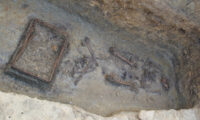 The iron folding chair discovered in August 2022 in the grave of a 6th century woman in Endsee, Bavaria, has been fully excavated a year after it was removed in a soil block. After its discovery, the chair was taken to the Bavarian State Office for Monument Preservation (BLfD) for excavation, study and conservation in laboratory conditions. An initial CT scan revealed that the folding chair was almost intact and was decorated with brass non-ferrous inlays. Those exceptional details have now been revealed.
The iron folding chair discovered in August 2022 in the grave of a 6th century woman in Endsee, Bavaria, has been fully excavated a year after it was removed in a soil block. After its discovery, the chair was taken to the Bavarian State Office for Monument Preservation (BLfD) for excavation, study and conservation in laboratory conditions. An initial CT scan revealed that the folding chair was almost intact and was decorated with brass non-ferrous inlays. Those exceptional details have now been revealed.
 The chair was deposited at the feet of an adult woman between 40 and 50 years old at time of death. She was adorned with fine jewelry, including a necklace of glass beads and a chatelaine attached to her belt with two bow brooches. Archaeological evidence suggest that she was not just wealthy, but held political office. The x-shaped folding chair was a symbol of her political position.
The chair was deposited at the feet of an adult woman between 40 and 50 years old at time of death. She was adorned with fine jewelry, including a necklace of glass beads and a chatelaine attached to her belt with two bow brooches. Archaeological evidence suggest that she was not just wealthy, but held political office. The x-shaped folding chair was a symbol of her political position.
 The folding chair is a simple design: two frames joined with an axle pin. This design is so ancient it has been found in Egyptian tombs going back 4,000 years, with written references from Mesopotamia going back 500 years before that. (Even then the x-frame chair was associated with rulership.) Two narrow slots on the horizontal struts were used to attach the seat. The seat has decomposed, but mineralized traces found on the chair indicate it was made of animal fur. The brass inlays feature geometric motifs, including herringbones, spirals and diamond shapes.
The folding chair is a simple design: two frames joined with an axle pin. This design is so ancient it has been found in Egyptian tombs going back 4,000 years, with written references from Mesopotamia going back 500 years before that. (Even then the x-frame chair was associated with rulership.) Two narrow slots on the horizontal struts were used to attach the seat. The seat has decomposed, but mineralized traces found on the chair indicate it was made of animal fur. The brass inlays feature geometric motifs, including herringbones, spirals and diamond shapes.
 The level of surviving decoration is unprecedented. Early medieval folding chairs are already extremely rare — 30 of them have been found in Europe, only two of them in Germany — and none of the others have anything like this density of detail.
The level of surviving decoration is unprecedented. Early medieval folding chairs are already extremely rare — 30 of them have been found in Europe, only two of them in Germany — and none of the others have anything like this density of detail.




These details are indeed awesome!
Also, I wonder if those inlays count as ‘niello’, but not in black and with gold, brass or other bronzes. Of course, the completed excavation does not mean that its restoration is completed also. Maybe, it will be presented in full splendor in the distant future.
PS: As a Middle Franconian, I need to point out that the chair is from “Endsee” in Bavaria, but not from Endsee in Rupolding in Bavaria, but instead from Endsee in Steinsfeld in (western) Middle Franconia, though still in Bavaria 😜️
Any more context would be helpful, i.e. maybe other nearby graves, symbols or inscriptions on that chair, or possibly any remaining structures of buildings. There is e.g. a ‘Burgstall’ in Endsee, i.e. what once seems to have been a castle.